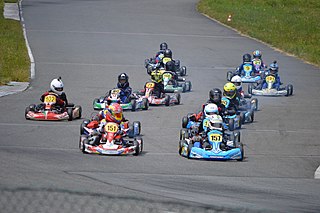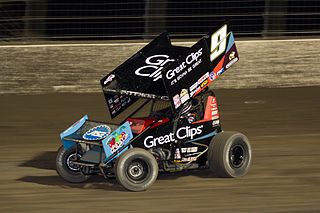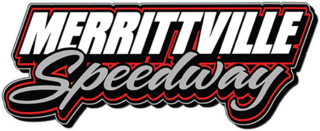
Stock car racing is a form of automobile racing run on oval tracks and road courses measuring approximately 0.25 to 2.66 miles. It originally used production-model cars, hence the name "stock car", but is now run using cars specifically built for racing. It originated in the southern United States; the world's largest governing body is the American NASCAR. Its NASCAR Cup Series is the premier top-level series of professional stock car racing. Australia, Canada, New Zealand, Mexico, Brazil and the United Kingdom also have forms of stock car racing. Top-level races typically range between 200 and 600 miles in length.

Kart racing or karting is a road racing variant of motorsport with open-wheel, four-wheeled vehicles known as go-karts or shifter karts. They are usually raced on scaled-down circuits, although some professional kart races are also held on full-size motorsport circuits. Karting is commonly perceived as the stepping stone to the higher ranks of motorsports, with most of the Formula One—including Sebastian Vettel, Nico Rosberg, Ayrton Senna, Max Verstappen, Lewis Hamilton, Michael Schumacher, Kimi Räikkönen, and Fernando Alonso—having begun their careers in karting.

Sprint cars are high-powered open-wheel race cars, designed primarily for the purpose of running on short oval or circular dirt or paved tracks. Sprint car racing is popular primarily in the United States and Canada, as well as in Australia, New Zealand, and South Africa.
Dirt track racing is a form of motorsport held on clay or dirt surfaced oval race tracks often used for thoroughbred horse racing. Dirt track racing started in the United States before World War I and became widespread during the 1920s and 1930s using both automobiles and motorcycles. Two different types of race cars dominate — open wheel racers in the Northeast and West and stock cars in the Midwest and South. While open wheel race cars are purpose-built racing vehicles, stock cars can be either purpose-built race cars or street vehicles that have been modified to varying degrees. There are hundreds of local and regional racetracks throughout the nation. The sport is also popular in Australia, New Zealand, Canada, South Africa and the United Kingdom.
The World Karting Association, or WKA, is the largest sanctioning body for kart racing in North America. The WKA was founded in 1971 and is located directly behind Charlotte Motor Speedway in Concord, North Carolina. The WKA is believed to currently have approximately 5,000 members. Over 50,000 people have been WKA members since the organization's inception in 1971.

Quarter midget racing is a form of automobile racing. The cars are approximately one-quarter (1/4) the size of a full-size midget car. The adult-size midget being raced during the start of quarter midget racing used an oval track of one-fifth of a mile in length. The child's quarter midget track is one quarter that length, or 1/20 mile.
Concord Speedway was a motorsports facility located in the town of Midland, North Carolina, southeast of Concord, North Carolina. The complex featured a 1⁄2-mile asphalt tri-oval and a 1⁄4-mile asphalt oval.

New Egypt Speedway is a 7/16 mile clay race track in New Egypt, New Jersey. The track hosted the NASCAR Whelen Modified Tour on a quarter mile asphalt track in the 1980s.

Southside Speedway was a short track used for stock car auto racing located just South of Richmond, Virginia in Chesterfield County. On Dec 11, 2020, the track announced it would be closing permanently after the 2020 season was cancelled due to COVID-19. It is a .333-mile (0.536 km) asphalt oval owned and operated by Sue Clements and Patsy Stargardt. The track originally canceled the 2011 racing season after announcing that owner Sue Clements was battling health problems. However, a shortened 11-week 2011 season took place, which saw the return of the Legends and Pro Six divisions.

Dominion Raceway is a motorsport complex currently operating in Thornburg, Virginia. The facility includes 4/10-mile oval track, a 2-mile road course, and a 1/8-mile drag strip. The track hosts NASCAR, SCCA, and Superkart events along with amateur road course and street racing events.

Volusia Speedway Park is an auto racing facility located near Barberville in Volusia County, Florida.
The Briggs & Stratton Animal is a single cylinder, four-stroke overhead valve engine used in many go-karting series, such as the IKF, WKA and others. It is based on Briggs & Stratton's 6.5 horsepower generator engines.
Bedford Speedway is a 5/8 mile oval, semi-banked, clay, race track located in Bedford County, near Bedford, Pennsylvania. The track is also known as the Bedford Fairgrounds Speedway and is host to the Great Bedford County Fair. The track hosts the All Star Circuit of Champions, World of Outlaws Late Model Series.

Modified stock car racing, also known as modified racing and modified, is a type of auto racing that involves purpose-built cars simultaneously racing against each other on oval tracks. First established in the United States after World War II, this type of racing was early-on characterized by its participants' modification of passenger cars in pursuit of higher speeds, hence the name.

Caffeine and Octane's Lanier Raceway is a 0.375-mile paved oval racetrack located just outside Braselton, Georgia. The track opened in 1982 as a dirt track, and was paved in the mid-1980s. It is currently owned and operated by High Octane, LLC, an auto events & multimedia business conglomerate. The track was under the NASCAR Whelen All-American Series banner with super late models, SuperTrucks, Junkyard Dogs, outlaw late models, mini stocks, INEX RaceCeiver/zMax legends cars and INEX bandolero cars. The track ended weekly racing at the end of the 2011 season, but remained open for larger events. In 2022, High Octane resumed weekly car events at the raceway for the first time since 2011.

The Brockville Ontario Speedway is a 3/8 mile dirt track in the city of Brockville, Ontario, Canada. It is located on County Road 29 about 10 kilometres (6 mi) northwest of Brockville. Commonly known as "The BOS", the track has been running a weekly racing schedule for most summers since 1969. The BOS has also run Go-Karts on Wednesday nights since 2005. They race on a smaller oval on the infield of the track.

Bandolero car racing is a type of entry-level racing in the United States and Canada. Many bandolero car drivers move into Legends racing. Cars can reach in excess of 70 mph, but do not accelerate very quickly. The most wins in Bandolero race cars used to be held by Joey Logano but was broken in 2016 by Clay Thompson. The cars are built like miniature stock cars, with a tube frame and sheet metal cage. Drivers enter through the roof of the vehicle. Most drivers range from 8 to 14 years old, but older drivers can also race. The cars race on 1/4 mile, 3/8 mile and 4/10 mile ovals and also road courses and dirt tracks. Currently, there are two divisions in Bandolero racing.

Orange County Fair Speedway is a 0.625 mi (1.006 km) dirt oval speedway in Middletown, Orange County, New York. The facility holds weekly stock car races and demolition derbies during the summer months. The track was built in 1857 for horse racing at the Orange County Fair and staged its first automobile race on August 16, 1919. The fair began as an agricultural exhibit in 1843 and was permanently located in the Wallkill–Middletown area in 1857. The speedway is located at 239 Wisner Avenue in Middletown on land which was known as The Ogden Tract in the mid-1850s. It was originally a half-mile horse racing track known as the Harry Clay Oval, named after a race horse that was famous at that time. Over the years, the track was widened and lengthened to a true 5/8-mile race track.

Bridgeport Speedway is a dirt speedway located in the community of Bridgeport in Logan Township, Gloucester County, New Jersey, that consists of a high banked, progressive 4/10 mile 0.375-mile (0.604 km) and a 1/4 mile 0.25-mile (0.40 km) oval located within the bigger track. The Super DIRTcar Series races at the track. Jason Leffler died in an accident at the track in 2013.

Merrittville Speedway is a 3/8 mile dirt short track motor racing oval, located 20 minutes west of Niagara Falls, in Thorold, Ontario, Canada. The track hosts a weekly Saturday night program that runs from April to September each year and features stock car, sprint car and modified races.














